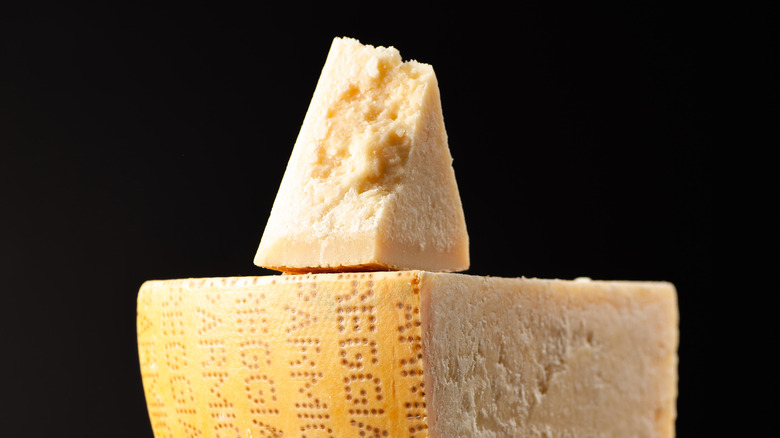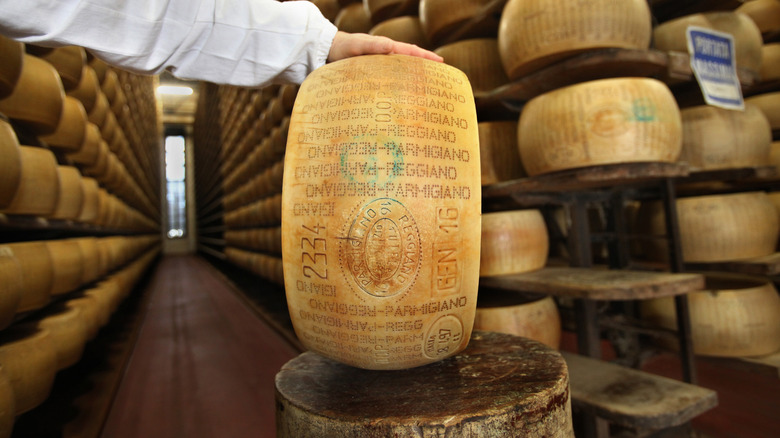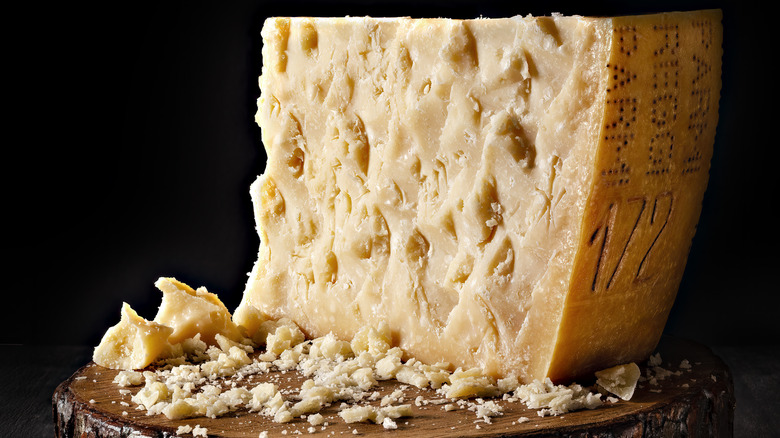The Reason Authentic Parmesan Cheese Wheels Are Imprinted With Dots
There's Parmesan cheese, and then there's authentic Parmesan cheese. You may not realize there's a difference, but authentic Parmesan cheese, officially sold under the name Parmigiano Reggiano DOP, is held to a much higher standard. It's exclusively produced in Italy and must pass a strict inspection in order to be considered authentic. If the cheese fails inspection or doesn't originate from Parma, Reggio Emilia, Modena, or Bologna, it legally cannot be called Parmigiano Reggiano or use the DOP seal.
The easiest way to tell if Parmesan cheese is authentic is by looking at the label, but the rind is also a reliable indicator. The rind of authentic Parmesan cheese is always perforated with dots, which are made by pressing a special stencil against the cheese. These dots collectively form the words "Parmigiano Reggiano" all over the rind and are also accompanied by the date, year, and the dairy producer. If a wheel of Parmesan doesn't include these markings, it isn't the real deal.
What makes Parmesan cheese dot-worthy
Cheese that's properly made by artisans and is produced in one of the designated regions isn't necessarily guaranteed to be authentic Parmesan by the time it finishes aging. Many factors are out of any cheese maker's control — air bubbles, for example, are considered a major defect. The slightest deviation in taste and texture can also risk Parmesan its DOP distinction.
For such rigorous quality standards, you might assume that only cheese that passes inspection would be dotted, but the truth is all wheels start off with the markings, which are imprinted well before the cheese even matures. The dotting happens when cheese is still in the curd stage. The curds get poured into the plastic wheel molds, which are lined with the dotted stencil. This cheese is left to sit for 24 hours in the molds, after which the resulting wheels are transferred to a brine before aging begins.
What happens to Parmesan that fails inspection
In addition to losing the right to be sold as Parmigiano Reggiano DOP, Parmesan cheese that fails inspection also gets stripped of its dots. The inspection takes place after the first 12 months of aging and involves categorizing the cheese as either premium or export-quality Parmigiano Reggiano, medium-grade Parmigiano Reggiano, or just regular non-DOP certified Parmigiano. Premium, export-quality, and medium-grade Parmigiano all get to keep their dots, but on medium-grade wheels, they're slashed. As for the wheels of non-DOP certified Parmigiano, the entire rind is removed, leaving no trace of the dots at all.
De-rinded Parmesan still ends up being sold as Parmesan, but it doesn't have the DOP seal and will also have a lower price point because of its lower quality. In some cases, this cheese is simply grated up, combined with other types of cheese, and sold as a Parmesan blend, like the kind that comes in the green plastic bottles.


